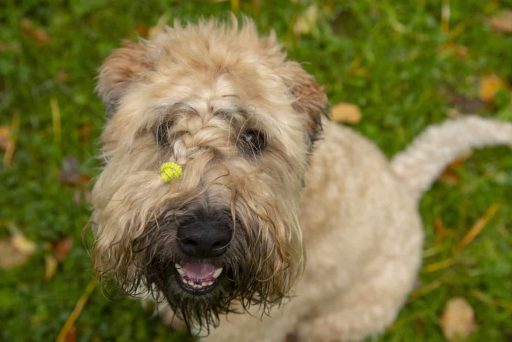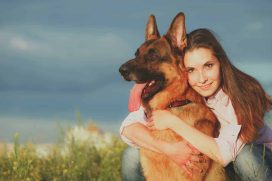If you are looking for a suitable family dog then you want to be sure that it isn’t going to be an aggressive dog. Some breeds are known more for being aggressive than others.
Are Whoodles aggressive? No, Whoodles are not an aggressive breed. They are an intelligent, friendly, sociable and energetic breed that make great family pets.
In general, a Whoodle will have a friendly temperament, are eager to please and are easily trained. This lack of aggression makes them the perfect breed to own if you’ve got kids or other dogs.
Why Are Whoodles Not Aggressive?
If you mix a Soft Coated Wheaten Terrier with a Poodle you get a Whoodle.
To answer the question of “are Whoodles aggressive?” we need to look at the parent breeds.
According to the breed standard of the Poodle, they are “very active, and intelligent, carrying himself with pride”. A Poodle has an air of distinction and dignity particular to himself.
Major faults in temperament include shyness or sharpness. Poodles were originally bred to be duck dogs and work closely with their people. Generally speaking, dogs that work closely with people do not tend to be aggressive. So, generally speaking a well socialised and cared for Poodle should not be aggressive.
The breed standard of the Soft Coated Wheaten Terrier states that the breed is “happy, steady, with an air of self-confidence”.
They are alert and interested in their surroundings. Soft Coated Wheaten Terriers exhibit less aggressiveness than is expected in others of the terrier group. Major faults include timid or overly aggressive dogs. This breed was bred to be an Irish farm dog. Doing everything from ratting to hearding to guarding the chicken coop, and even being a bird dog.
This breed, like the Poodle, were bred to work with people. As the breed standard states, Soft Coated Wheaten Terriers should not be aggressive.
So, from the information, we just learned about Poodles and the Soft Coated Wheaten Terrier we can conclude that Whoodles should not be naturally aggressive.
However, there are always exceptions to the rules.
What can affect The Temperament Of A Whoodle?
Any dog has the potential to be aggressive if provoked, but some will be easier to agitate than others.
Just like with people, dogs have a personality and temperament that is a product of its environment and its genetics. Before bringing a dog into your home, it’s a good idea to find out a bit more about the dog and where it has come from, especially if it is a rescue dog.
Here are a few things to consider before choosing a Whoodle (or any dog breed)
1. Breeding
When you choose a Whoodle you need to be very careful about where you get it. Buying a Whoodle puppy at a pet store or from a stranger in a parking lot is a definite no no. This is likely a puppy from a puppy farm/mill. Puppy mills have nothing in mind but money and do not care about the health, temperament, or longevity of the puppies they produce.
Also, be careful of looking at the classifieds or other backyard breeders. While these people may think they know what they are doing you can’t be sure. You have to put in a ton of hard work to produce a good litter of puppies. There is a lot to consider including the health, temperament, physical attributes, and longevity of the parents, their parents, and even their parents! This is the best way to secure a healthy, happy litter. This is a lot of work and most backyard breeders do not do it.
You want to choose a Whoodle breeder who is breeding puppies for the best puppies ever. They should breed for health, longevity, and temperament. It is best if you can meet the parents and as many relatives as possible. Do any of them seem aggressive? If even one relative seems aggressive, know that your pup could have a throwback gene that may make them tend toward aggression.
2. Socialization And Training
Another thing that a good breeder will do is an extensive amount of socialization and training in the first 8 to 12 weeks of the puppy’s life. Whoodles are easy to train and are eager to please, so this is an easy task even if you have never owned a dog before.
Socialization happens whenever a puppy is exposed to something different. A different dog, noise, smell, surface, person, environment, room, even being touched all over, all of these and more are considered socialization.
Good breeders look for as many opportunities to socialize their puppies as possible with other dogs, sounds, sights and adults.
The key is not just to expose the puppies to these things but to also make sure the pups have positive experiences with all these things. If a puppy has just one negative experience with say a cat, they can be fearful and potentially aggressive to cats for the rest of their lives. This is why choosing an excellent breeder is so important.
Socialization does not stop with the breeder, however. You must continue the good work they started once you bring the puppy home. A good puppy training class can be a great way to socialize your puppy. Having everyone you know come over to visit your puppy is great too. But remember, your puppy needs to have a positive experience, so keep the treats and fun nearby.
While working with your puppy on socialization, its a good idea to know a few calming signals. Calming signals are a dog’s way of letting you know that they are stressed or trying to diffuse a situation.
Yawning, licking of lips, turning their head away, play bows, sniffing the ground, sitting with a paw lifted, laying down, and walking in a curve can all be calming signals. Some dogs will go as far a urinating on themselves, known as submissive urination, to let you or another dog know they are no threat.
3. Bite-Inhibition
Puppies learn early on from their litter-mates how to play. They play and mouth one another, but when it’s too hard of a bite, they YELP! This is a way for puppies to teach each other bite-inhibition.
Letting each puppy gain control of their jaws. What is too hard that it created damage? I didn’t want to hurt my sister, I was just having fun. That said, be wary of getting a puppy that was the only pup of a litter. Their bite-inhibition could be very lacking.
A good breeder, and later you, should continue the bite-inhibition training. You don’t simply want to train your dog to not bite, though this can come later. First, encourage your dog to bite you. When they bite too hard Yelp! and stop the game for a bit. This will let the pup know that if they bite that hard you won’t play and the fun stops. Progressively, you will yelp for softer bites, until your dog isn’t biting at all but just barely putting its teeth on you.
Why is this better than just teaching a dog to not bite? If you get after a dog every time he bites, he won’t learn how to control his jaws in the same way. Dogs are very capable of learning how hard they can bite humans (teeth just barely touching skin) and how hard they can bite other dogs while playing. They can make the distinction. If you get after your dog for biting and mouthing you at all, he will not learn this. And if he decides he needs to defend himself against a human he will bite hard. If he has bite-inhibition he will not bite hard but give what may seem to be more of a warning bite.
Bite-inhibition is something essential to the training of all dogs.
4. Aggression vs. Reactivity
Aggression in dogs is something we have all heard of and some of us may have even experienced this. Aggression can be demonstrated toward other dogs, animals, or people. Aggressive behaviors include the dog becoming still and ridged with an erect tail, growling, snarling, lunging, nipping, baring teeth, and biting.
It is not a rare thing to be walking along and see two dogs being walked. One may seem calm and be minding his own business. The other is barking wildly and lunging at the end of his leash. Your first thought would probably be that the lunging dog is aggressive. However, this may not be true.
Reactivity can often look very similar to aggression. Reactivity comes from a different place than aggression. Aggression mostly stems from a desire to protect or dominate. Reactivity comes from fear. That dog that you saw lunging and barking at the end of his leash. He wasn’t being aggressive, he was having a full-blown panic attack at the sight or smell of the other dog.
Both aggression and reactivity are complex issues. Typically they can both stem from poor socialization, pain, breeding, and even diet plays a role. It can be helpful to seek professional help to find out if your dog is truly aggressive or reactive. Then you can work with that professional to help to recondition your dog. Reconditioning for both aggression and reactivity are very similar.
For both reactivity and aggression, there is always a “trigger.” Something that makes the dog go-off. When they see that thing or are in that situation that is the trigger. Pay close attention. Perhaps your dog gets aggressive when she has a bone to chew on or when she is eating. Maybe, your dog goes berserk when he sees a person in uniform or he goes crazy with a dog larger than him. Whatever the trigger, or triggers, take note.
Once you find the triggers you can avoid them. When you see a potential trigger coming your way, go the other way or remove your dog from the situation. Or in the case of a dog protecting a bone or food, keep people and other animals away to avoid an issue. The aggressive or reactive response is like a muscle. The more your dog works it, the stronger the response gets.
Another thing that you are going to do with the trigger, is to use it to help recondition your dog. Perhaps your dog is aggressive or reactive to small dogs. You can use this knowledge for training. When you see a small dog at a distance, treat and praise your dog before she reacts. Work closer and closer over time. Eventually, you will get to a point where your dog can walk by a small dog and not react, at least most of the time.
Reconditioning is a great training method and can be of great help to your aggressive or reactive dog. It’s best to do this with a trainer who is familiar with the issue and can help you.
It’s also important to note that in neither case, aggression or reactivity, the dog should not be punished. Punishing an aggressive dog can make things much worse. Also, imagine being in the middle of a panic attack and having someone come over and yell at you or slap you. Would that help? No, but that is what you would be doing if you punished a reactive dog for reacting. Positive reinforcement is the way. Teaching the dog that being happy, confident, and nice pays off bigger than being lungy or barky.
In Conclusion
In general, Whoodles are not aggressive. Though this can depend a lot on the breeding and socialization of the individual dog. Socialization is an important life-long practice for all dogs and people. It is crucial to teach all puppies bite-inhibition. If your Whoodle should become aggressive or reactive there is hope. Seek the help of a professional trainer to help you counter-condition and recondition your dog. Help your dog learn that it’s way better to be happy, confident, and have fun then it is to lunge, bark, and bite.
Resources
http://images.akc.org/pdf/breeds/standards/SoftCoatedWheatenTerrier.pdf
https://images.akc.org/pdf/breeds/standards/Poodle.pdf
https://www.smalldogplace.com/dog-breeders.html





